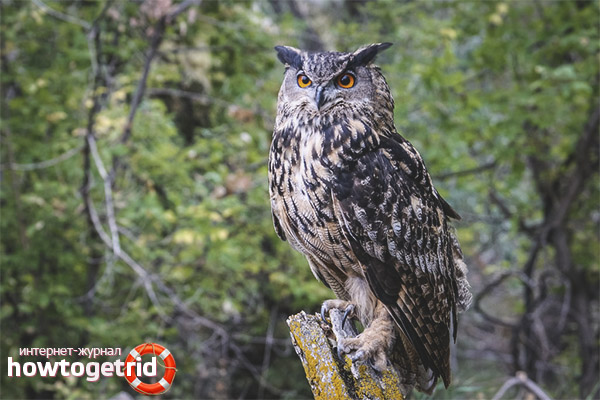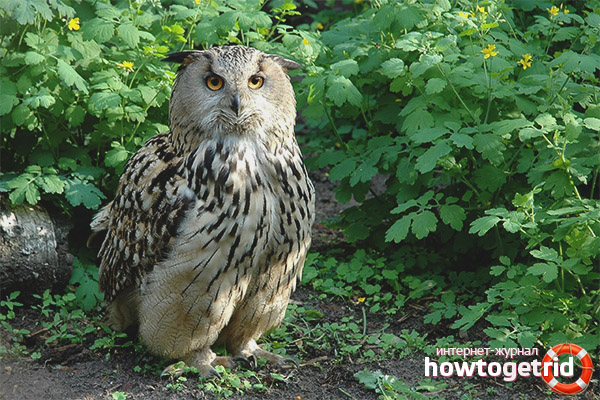The content of the article
To date, quite a lot of representatives of the owl family are distinguished, an owl is included in this list. There are many birds that are similar in appearance, behavior and lifestyle. But today we will consider it is an eagle owl, which is a predator by nature. We will not run ahead by revealing the cards, so that after the information received you will form your own opinion.
Description
- Owls mean an ardent representative of an owl family, which is distinguished by its overall characteristics. Of the entire category, these individuals are the largest and strongest. On the body of the bird grow up to 75 cm. With a weight of 4 kg. The smallest eagle owl is considered to be Guinean, according to its dimensional data it grows to a maximum of 44 cm with a weight of 0.8 kg. Among the birds of the group under discussion, gender differences are developed; females are always larger than males.
- A distinctive characteristic of these individuals is a downed barrel-shaped case. Owls are rather stocky, their tousled plumage gives even greater volume. A stocky physique is accompanied by shortened and strong legs, fingers are strong and clawed, pigmented with light or black. Due to the claws, the bird can grab prey or hold on to branches. Feathers are present in the fingers, but not always.
- The wings are powerful, elongated, quite impressive in scope. In large specimens, the scope reaches two meters. As for the tail, it is medium in length, rounded at the end. A round-shaped head, wide, strewn with handfuls of feathers. These birds are characterized by so-called owl ears, which are located on the sides of the head. It is this feature that is distinctive for birds of this kind. Ears can be wide or close, small or large.
- The beak is short, not flattened from the sides, powerful, pigmented in black. At the end, it bends down, so that birds can click their mouth. The little eagle owl of the Guinean breed is famous not for the dark, but for the gray-blue beak. The area of the nostrils is covered with a short plumage, which is similar to the bristles.
- Birds have loose, fluffy and compacted plumage. By color they are brown-red, gray with smoke, there are stripes of a vertical type, located vertically. Speckles cover the back, head, and shoulder joints. The chest and neck area are not so pronounced, there is plumage in the form of horizontal pockmarked stripes.
- The eyes are large, round, I can be orange or yellowish. Also there are representatives of the family with red eyes. Some types of owls have brownish irises. The eyes are directed to the front, the look is straight. Birds can observe what is happening, without completely moving the hull.
- The feathered tribe does not see a color picture, all owls have black and white. Individuals of this group see everything perfectly in the daytime, but for some reason most people believe that in the light of day these individuals are blind. On the contrary, they can see prey even at a great distance. The pupils of a feathered friend are hypersensitive, can narrow-expand when the bird breathes in and out.
- Birds can boast excellent eyesight at night and twilight, as well as similar members of the family. The eyes of the telescopic format are the camera lens (conditionally). Thanks to this, even the smallest light flashes are involved, birds turn them into full-fledged light. But during a night hunt, owls focus more on sound, rather than on sight.
Habitat
- These birds are by nature considered predators, they are common in African, European, South American countries. Also found individuals in Eurasia, North America, the United States. Not without living in the vastness of our homeland.
- Many eagle owls in Latin America, India, China, Pakistan, Japan, Thailand, Korea, Japan. These birds live throughout the territory of the Russian Federation, they are found in Siberia, in the European part, the Primorsky Territory and the Amur Region.
- Among the common areas where these birds settle, urban parks, desert and forest tracts, as well as the mountainous area and the area near agricultural land are distinguished.
Nutrition
- According to their eating habits, all eagle owls are almost the same, with the exception of fish eagle owls. He eats, as the name implies, floating inhabitants. As for the West African bird, it has small claws, the individual is forced to eat cockroaches, beetles, and other insects.
- Other representatives of the species make up their diet more diverse. It may include the most unpredictable creatures. Eagle owls prey on reptiles, so they eat snakes, turtles and lizards. They can treat themselves to rodents, including hamsters with mice, as well as voles, ground squirrels, hares, nutria, etc.
- Of the birds, eagle owls hunt mallards, geese, pheasants, hazel grouse, herons, magpies, partridges, etc. Mammals of the other type are on the menu of the feathered tribe. Among them are deer, roe deer, mongooses, hedgehogs, goats, badgers, bats.
- It was previously mentioned that some members of this family consume aquatic inhabitants. Among them are toads, frogs, crustaceans, fish, etc.
- The food of these feathered friends is based on the remains that birds find from their brethren. They also pull the bait out of the trap, can adjust the diet depending on the habitat.
Hunting
- It is worth noting that owls, unlike owls, lead an active lifestyle regardless of the time of day. The considered individuals can hunt constantly. As for daily activity, they prefer cloudy days more. Owls and owls have almost the same way of hunting. Only the owl and the polar owl have differences.
- If we consider the polar owls, we can see that such predators, when hunting, begin to look for a prey from the ground. Such an individual will sit motionless on a small hill. As soon as dusk sets in, the owl changes its hunting method. She begins to chase the victim, driving her.
- In addition, a polar predator can grab prey on the fly. Before this, the bird hangs over the victim, begins to tremble and grabs it. As for fish owls, they often hunt from steep shores that are prone to various water bodies. Also, birds can hunt from tree branches that stand in shallow water.
- It is the fish eagle owls that most of their relatives walk on the earth. Often in their habitats you can even see characteristic trails. Often they are trodden along the coast near water bodies. All other species of such predators hunt differently. They make short flights over water or land. After this, a short rest on the hill follows.
- During the rest, the eagle owl tries to look out for more victims. As soon as a predator notices a potential prey, he quickly rushes after it. As soon as the eagle owl catches up with the victim, he immediately pierces it with his claws. It is worth noting that the birds in question are excellent fish hunters. They very skillfully dive into the water after her.
- If the opportunity arises, then owls can feast on various small animal foods, which they swallow right away. Often there were cases that even when an eagle owl caught a hedgehog, he did not always remove the skin with needles from it. The predator simply swallowed it whole.
Differences of an owl from an owl
- Such species as owls and owls are very common. As for the differences, they relate to external signs and habits. It should be noted that owls have much larger sizes and body weight. Their weight without problems can be more than 4 kg. Owls in this case, the food weighs 2 kg.
- In addition, owls can be distinguished from owls in that the former have interesting tufts of feathers growing on their heads. They are often called feather ears. As for owls, then their top is absolutely even. Only some subspecies can boast of this (striped and eared owls).
- In addition, the examined disc has a weakly pronounced facial disc. In owls, on the contrary, one can observe a more pronounced facial mask of light or dark color. Owls have a completely different diet. Often, small rodents are on their menu. Owls owing to their impressive size can hunt deer and goats.
- At the eagle owl at the tips of the feathers you can see a pointed shape. In owls, on the contrary, they are rounded. During the flight, owls almost soar silently. When an owl flies, it can be heard by a characteristic whistle.
Interesting Facts
- Owls are great hunters. Thanks to sharp vision, an individual even at night leaves no chance for its prey. In addition, they move quietly enough and have a camouflage color.
- The eagle owl is very strong and at the time of hunting it can even lift a fox into the air. Separately, it is worth mentioning that the head can be rotated 360 degrees for the individuals under consideration.
- Presented predators are unique in nature, they can breed in almost any environment. Eagle owls survive in mountainous areas, forests, steppes and even desert without problems.
Do not forget that the eagle owl belongs to predators, so it will not be able to get along with similar individuals. As for breeding, in such birds it begins in early spring. The female can give clutch up to 4 eggs. The incubation period does not exceed 35 days. All this time the male feeds and protects the female, the dwelling.
Video: Eagle Owl (Bubo bubo)












Submit